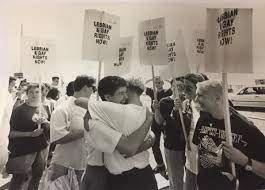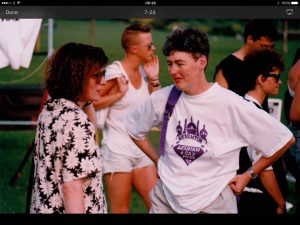Note: This opinion piece was first published in Brighton & Hove News 30 September 2023.
I recently visited the Pride exhibition at Jubilee Library. Despite concerns about

Dani Ahrens (front left) outside the Brighton Centre
modern Pride’s commercialism and divisions regarding sex based rights and gender ideology, I defy anyone not to be touched by the old black and white photographs of the very first march fifty years ago and the bravery of those involved.
Very few people attended that early march, possibly twenty, but many more attended related events. Those were times when, at last, people spoke of being glad to be gay, rejecting the notion that to be homosexual meant a life of repression and misery.
Some present on the day, like the late hugely talented Graham Wilkinson, came to dominate the local campaign for homosexual equality, co-founding the Sussex Aids Helpline in 1985.
Though Graham’s portrait wasn’t on display, it was good to see large contemporary portrait photos of what I assume were early campaigners, now well on in years, facing out across the Square. And yet, I ask. Why so few lesbians?
Just three of the ten portraits were of females and the word lesbian appeared just once in the exhibition. This may be understandable given that there seem to have been few women on that first march. Perhaps there weren’t many women in the Sussex Gay Liberation Front which organised it.
However, my recollection of the seventies and eighties in Brighton is that women were very active in the movement for lesbian and gay rights as well as the women’s movement. Certainly, by the late 1980s and early 1990s, lesbians took a leading role in struggle against Section 28. They were also heavily involved in the 1991 revival of Pride marches as highly political protests, after some 18 years in which they did not take place.
The late 1970s brought huge changes to Brighton. Feminists argued that the personal was political. This was not an early expression of identity politics. It reflected an Increasing awareness among women, that low pay and harassment in the workplace, as well as unpaid labour in the family, were not natural things, but part of the way society was organised – and could be changed.
Feminists challenged the assumption that women were naturally emotional, irrational or intellectually inferior to men. They rejected sex-role stereotyping and the enforced pregnancy many had experienced. Women who had experienced sexual and physical violence began to call themselves survivors, not victims, and to demand redress through the courts.
Many of these so-called ‘second wave’ feminists were radical lesbians, who often led debate. Heterosexual women had to move over and most were happy to do so, while women keen to involve male partners moved on pretty smartly. Some embraced lesbianism as a political choice, a decision viewed with amused tolerance by established lesbians.
It was at this time that many of our local women’s organisations were set up, the Women’s Centre, Brighton Women’s Aid, Rape Crisis Centre and later the Incest Crisis Line, all of them female-only services, often run as collectives and later charities, always by women.
Local women read feminist books, attended consciousness-raising groups and learned self-defence. They campaigned for refuges, equal pay and abortion rights and demanded peace, camping out in the 1980s at Greenham Common (and for a while, on the Level). Lesbian separatists set up collective households in Brighton which became informal feminist campaign centres, where straight and lesbian women learned and socialised. There was one such household in St James Street, an area which wasn’t then quite as male-focused as it later became.
Lesbians actively supported Gay Switchboard, but also started a local Lesbian Line, so that young women questioning their sexuality could speak freely to other women. This is still needed. Nowadays young lesbians are too often persuaded they’re ‘really’ boys.
As women, lesbians rarely had the financial resources of gay men. There were pubs that welcomed them, but no dedicated clubs. Women’s discos took place in a very few pubs and community centres, like the old Resource Centre, before it was burned down. There lesbian feminist punk bands like Bright Girls (formerly the Devil’s Dykes) played to crowds of women drinking at candle-lit tables.
As time went on, some lesbians moved to fashionable places like Hebden Bridge, but a significant number stayed behind and became stalwarts of Brighton and Hove’s voluntary sector.

Linda Pointing (right) with Jean Calder (left)
There were many acts of protest. In 1990 four local lesbians, ably supported by one gay man, carried hand-drawn placards declaring “Lesbian Mothers aren’t Pretending” onto the stage of the International Congress of the Family, held at the Brighton Centre. This deeply anti-feminist and homophobic organisation had invited Princess Diana as their guest of honour. The ‘lesbian protest’, staged directly behind Diana, made national news.
Local activist Dani Ahrens played a leading part in that protest and another the following year, when activists, including lesbian historian Linda Pointing, carried a huge banner into the Brighton Council Chamber, and held it up in front of the Mayor, the late and much missed, Joe Townsend. Joe refused to order their removal, so there they remained with aching arms and backs, suffering for the cause.
In recent years, our Council has embraced a multiplicity of ‘genders’. It is vital that, in the process, our city does not squander its rich history of struggle for women’s sex-based rights and of lesbian feminist activism. Women’s history has for centuries been hidden or suppressed. Organisations like the Women’s History Group and the Mary Clarke Statue Appeal exist to rediscover it.
However, it’s depressing to think that despite the women’s movement, recent fashionable ideologies may serve to make homosexual female relationships invisible once again – and make same-sex attracted young women ashamed to call themselves lesbian.
I look forward to a time when I will see displays in our museums about local lesbian and feminist history – and in exhibition spaces, portrait photographs of, among others, pioneering women such as: Dani Ahrens; Linda Pointing; Joan Mortimer; Shirley West; Tash Fairbanks; Melita Dennett; Jill Gardiner; and Val Brown.
Those are a few great names. Just for starters.
